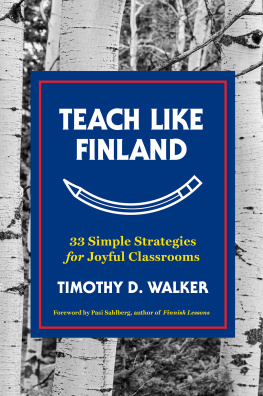

ABOUT THREE YEARS AGO, I RECEIVED A BRIEF EMAIL from an editor named Deborah in New York City. (I was halfway through my first year of teaching in Helsinki and I was running a little blog called Taught by Finland.) Deborah wanted to know if Id thought of writing a book. I hadnt.
Im so grateful to Deborah Malmud for believing, from the very beginning, that I could write Teach Like Finland. Also, Im thankful for the rest of the Norton team for their world-class assistance throughout this project.
Additionally, I want to thank Pasi Sahlberg who, since my first year of teaching in Helsinki, has encouraged me to keep writing about Finnish education from an outsiders perspective; Im so glad he wrote this books foreword. Also, Im grateful for my former colleagues and students at Ressu Comprehensive School, where I worked for two good years. In writing this book, I chatted with a handful of Finnish educators from other schools, and Im thankful for their willingness to speak with me.
Before teaching in Helsinki, I was mentored by several gifted American educators. Many thanks to Brian, Henry, Joanna, Kathy, Linda Lue, Lisa, Steven, and Tricia. Additionally, I want to express my gratitude for my wife Johanna and our children Misaiel and Adalia, whose love brings me a lot of joy. And lastly, I give my deepest thanks to God for his gracious provision.
IN MY FIRST YEAR AS A CLASSROOM TEACHER IN ARLINGTON, Massachusetts, I was on the fast track to burnout. On weekdays I would arrive at my school around 6:30 A.M. and exit sometime in the evening, usually with a backpack full of teaching guides. When I wasnt at school, I tried disconnecting from the work, but I couldnt. At breakfast I anxiously pored over my lesson plans, and in the evening, as I lay in bed I obsessed about all of the things I was doing wrong. On a typical night Id wake up four or five times. Sometimes I felt so anxious in the morning that Id run to the bathroom in my apartment and throw upgross, I know.
Before starting this first year of classroom teaching, I was so enthusiastic, so confident that Id love this job. But when October arrived, I started to admit to myself that I was hating this job. It wasnt bringing me joy. The opposite was taking place, actually.
My Finnish wife, Johanna, was very worried about me. She warned that if I didnt slow down Id need to take a leave of absence. I said, Never. Johanna wondered why I insisted on working nonstop. She told me about her Finnish friend in Helsinki, a first grade teacher just like me, who worked no more than six hours every day, including an hour or two of prep. When she left her public school around 2:00 P.M., she left all of her work behind, too.
I assumed that Johanna misunderstood her friends workload. Or, I reasoned, if my wife had the facts straight, her friend wasnt a good teacher. Good teachers, I told my wife, dont do short workdays. In fact, I explained, they push themselvesto the limit.
Not in Finland, Johanna said.
After my wife graduated from Finnish high school, she spent a few months working as a substitute teacher in Helsinki, which provided her with a behind-the-scenes look at the working lives of Finlands educators. In Finnish schools, teachers and students typically have a fifteen-minute break built into every hour of class, and, in Johannas experience, most educators would spend their breaks in the loungedrinking coffee, chatting with colleagues, and flipping through magazines. It sounded, given my American teaching experience, pretty farfetched.
At my Massachusetts school, during my extended lunch blockusually my only scheduled break during my workdayId often work through the free time, zigzagging across my American classroom with a peeled banana, nibbling on-the-go as I prepped for afternoon lessons.
Throughout my first year of classroom teaching, my Finnish wife was doing her best to convince me that there was another way to teach. And not just survive but thrive. I wasnt buying it, though.
My reality, which I shared with many American teachers, seemed too different from those teachers in Finland. I didnt have those fifteen-minute breaks scattered throughout the day. My last class was still in session when Johannas friend would leave her school at 2 P.M. And I had, from my perspective, a mountain of classroom prep waiting for me after I waved goodbye to my first graders around 3:00 P.M.
During my rookie year of classroom teaching, I was typically putting in twelve-hour days, and somehow I thought this made me a much better teacher than Johannas friend. But by the end of that year, I knew I was clearly the weaker educator. A terrible lack of worklife balance had caught up to me, and I was brimming over with stress and anxiety. Worst of all, the job of teaching was no longer joyful, and my lack of satisfaction seemed to be rubbing off on my students. Those little kids often looked miserable, too.
That school year, I remember a veteran colleague telling me that 50 percent of American teachers leave the profession within five years. And I thought I was going to be one of those early dropouts. In late February, my anxiety and level of sleep deprivation had become so intense that I could no longer prepare lessons for the next day of school. I remember having sessions at my desk, where Id spend minutes staring blankly at my planner. One late afternoon, after another fruitless hour of classroom prep, I returned home and collapsed on the kitchen floor, lying speechless on the ground while my wife pleaded that I take a break. Humbly, after weeks of sleepless nights, I picked up the phone and requested a leave of absence.
I felt ready to move on from the profession and pretend that it had just been a bad dream. But I also wondered if my Finnish wife was right.
Was it possible to teach and thrive? Even in an American classroom?
Three years later, Johanna and I decided to move to Finland. It wasnt because I wanted to flee American education. On the contrary: I didnt want to leave. I was still teaching at the same school, grateful to have survived that embarrassing first year. After my month-long leave of absence, I had received valuable support and experience, and, over time, I was starting to tap into the joys of teaching, despite feeling physically and emotionally exhausted when I returned home from school every day.
The year before we moved to Helsinki, I was teaching full-time, completing graduate coursework, and working several part-time jobs. All things considered, I wasnt spending nearly as much time at home as I would have wishedand maybe, if I was honest with myself, I was slowly starting to burn out again. We decided to move to Finland, where we hoped for a slower pace, especially during our childrens early years. (Today we have two children under five years old.)
When I announced our plan to settle in Helsinki, my American principal remarked that it was a career move for me. I remember laughing at the idea, because it felt like the opposite. I was prepared, in Finland, to stop teaching all together, just to live a more balanced life. We purchased our one-way tickets to Helsinki without knowing if I would even have a job.
In late June 2013, one month before moving overseas, I still lacked a job as a classroom teacher, but I received a curious e-mail one morning from a Helsinki principal. I had contacted her in March, along with several other Finnish principals, and when I hadnt heard from any of them, I had stopped hoping. But there in my inbox that June morning was this message, which invited me to chat about the possibility of teaching an English-speaking fifth grade class at a Helsinki public school. My jaw dropped.
Next page










